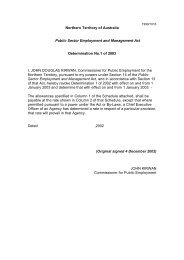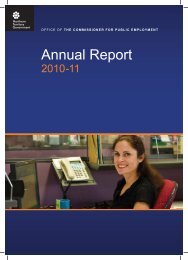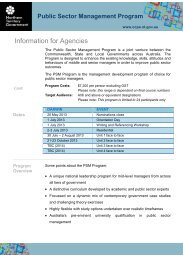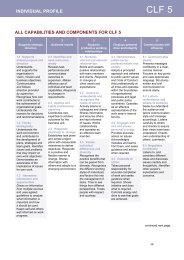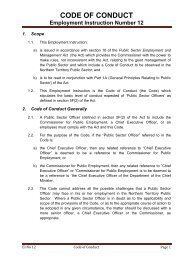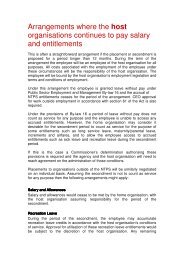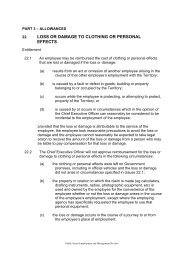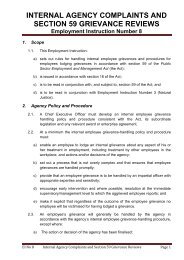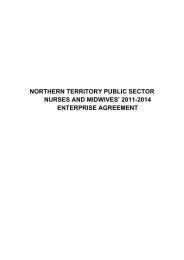Acknowledgement and Welcome to Country - Office of the ...
Acknowledgement and Welcome to Country - Office of the ...
Acknowledgement and Welcome to Country - Office of the ...
You also want an ePaper? Increase the reach of your titles
YUMPU automatically turns print PDFs into web optimized ePapers that Google loves.
THE OFFICE OF THE COMMISSIONER FOR PUBLIC EMPLOYMENT<br />
Pro<strong>to</strong>cols for<br />
<strong>Acknowledgement</strong> <strong>and</strong><br />
<strong>Welcome</strong> <strong>to</strong> <strong>Country</strong>
<strong>Acknowledgement</strong>s<br />
The <strong>Office</strong> <strong>of</strong> <strong>the</strong> Commissioner for Public Employment, Nor<strong>the</strong>rn Terri<strong>to</strong>ry<br />
Government, expresses its thanks <strong>and</strong> acknowledges <strong>the</strong> Department <strong>of</strong><br />
Education, Government <strong>of</strong> Western Australia, for its willingness <strong>to</strong> make <strong>the</strong><br />
Pro<strong>to</strong>cols for <strong>Welcome</strong> <strong>to</strong> <strong>Country</strong> <strong>and</strong> <strong>Acknowledgement</strong> <strong>of</strong> Traditional<br />
Ownership readily available. Adaptations have been made <strong>to</strong> suit <strong>the</strong> Nor<strong>the</strong>rn<br />
Terri<strong>to</strong>ry Public Sec<strong>to</strong>r with permission.<br />
© Copyright <strong>of</strong> <strong>the</strong> Nor<strong>the</strong>rn Terri<strong>to</strong>ry Government, 2010.<br />
Version 1, June 2010<br />
Fur<strong>the</strong>r information<br />
Contact Strategic Workforce Planning <strong>and</strong> Development,<br />
<strong>Office</strong> <strong>of</strong> <strong>the</strong> Commissioner for Public Employment<br />
email: swpd.ocpe@nt.gov.au or phone (08) 8999 5511<br />
- 1 -
Introduction<br />
It is important that <strong>the</strong> communities <strong>and</strong> environments in which <strong>the</strong> Nor<strong>the</strong>rn<br />
Terri<strong>to</strong>ry Public Sec<strong>to</strong>r (NTPS) operates <strong>and</strong> delivers services in, duly recognises<br />
<strong>and</strong> values <strong>the</strong> significance <strong>of</strong> Australia’s Aboriginal <strong>and</strong> Torres Strait Isl<strong>and</strong>er<br />
cultures <strong>and</strong> peoples.<br />
It is equally important <strong>to</strong> embrace <strong>the</strong> spirit <strong>of</strong> reconciliation between Aboriginal<br />
<strong>and</strong> Torres Strait Isl<strong>and</strong>er people <strong>and</strong> o<strong>the</strong>r Australians, <strong>and</strong> for <strong>the</strong> NTPS<br />
employees <strong>to</strong> be inclusive <strong>of</strong> all groups.<br />
Due recognition <strong>of</strong> <strong>the</strong> Traditional Cus<strong>to</strong>dians <strong>of</strong> country assists in developing<br />
strong partnerships with Indigenous communities across <strong>the</strong> Nor<strong>the</strong>rn Terri<strong>to</strong>ry.<br />
Therefore it is important that Aboriginal <strong>and</strong> Torres Strait Isl<strong>and</strong>er cus<strong>to</strong>dianship<br />
<strong>of</strong> country is recognised where Nor<strong>the</strong>rn Terri<strong>to</strong>ry Government (NTG) agencies<br />
events are held.<br />
The NTG is committed <strong>to</strong> providing a supportive <strong>and</strong> culturally inclusive<br />
workplace environment for all public sec<strong>to</strong>r employees. In particular, we need <strong>to</strong><br />
recognise <strong>and</strong> respect Aboriginal <strong>and</strong> Torres Strait Isl<strong>and</strong>er people <strong>and</strong> <strong>the</strong><br />
cultures by supporting <strong>the</strong> continuation <strong>of</strong> traditions, improving cross-cultural<br />
underst<strong>and</strong>ing <strong>and</strong> engendering mutual respect.<br />
Showing respect <strong>and</strong> appreciation for <strong>the</strong> cultural diversity will also greatly<br />
enhance our reputation as an attractive employer <strong>and</strong> an employer <strong>of</strong> choice for<br />
Aboriginal <strong>and</strong> Torres Strait Isl<strong>and</strong>er people.<br />
Recognition <strong>of</strong> Aboriginal <strong>and</strong> Torres Strait Isl<strong>and</strong>er traditional cus<strong>to</strong>dianship <strong>of</strong><br />
country through a formal process called <strong>Welcome</strong> <strong>to</strong> <strong>Country</strong>, will support this<br />
commitment <strong>to</strong> delivering <strong>the</strong> best services <strong>to</strong> communities <strong>and</strong> having<br />
workplaces that are more representative <strong>of</strong> <strong>the</strong> community we serve.<br />
- 2 -<br />
Image: Red Lily Billabong, Kakadu National Park, NT
His<strong>to</strong>ry <strong>of</strong> <strong>Welcome</strong> <strong>to</strong> <strong>Country</strong><br />
Pro<strong>to</strong>cols<br />
A <strong>Welcome</strong> <strong>to</strong> <strong>Country</strong> is an important ceremony for many Indigenous groups<br />
around <strong>the</strong> world <strong>and</strong> has been a part <strong>of</strong> <strong>the</strong> Aboriginal <strong>and</strong> Torres Strait Isl<strong>and</strong>er<br />
culture for thous<strong>and</strong>s <strong>of</strong> years.<br />
Arranging a <strong>Welcome</strong> <strong>to</strong> <strong>Country</strong> ceremony that acknowledges <strong>the</strong> Traditional<br />
Cus<strong>to</strong>dians <strong>of</strong> <strong>the</strong> l<strong>and</strong> shows respect for Aboriginal <strong>and</strong> Torres Strait Isl<strong>and</strong>er<br />
people as Australia’s First Peoples.<br />
Practices such as a <strong>Welcome</strong> <strong>to</strong> <strong>Country</strong> enable <strong>the</strong> wider community <strong>to</strong> share in<br />
Aboriginal <strong>and</strong> Torres Strait Isl<strong>and</strong>er culture, <strong>and</strong> lead <strong>to</strong> better community<br />
relationships <strong>and</strong> underst<strong>and</strong>ing. This practice connects participants with <strong>the</strong><br />
country, <strong>and</strong> provides a welcoming atmosphere <strong>and</strong> spiritual presence <strong>to</strong> <strong>the</strong><br />
place upon which people are meeting.<br />
The observation <strong>of</strong> cultural pro<strong>to</strong>cols <strong>and</strong> <strong>the</strong> sharing <strong>of</strong> cultural practices can<br />
enrich relationships between local Aboriginal <strong>and</strong> Torres Strait Isl<strong>and</strong>er<br />
communities <strong>and</strong> o<strong>the</strong>r cultural groups.<br />
Reconciliation Australia provides a great insight in<strong>to</strong> <strong>the</strong> his<strong>to</strong>ry <strong>of</strong> <strong>Welcome</strong> <strong>to</strong><br />
<strong>Country</strong> pro<strong>to</strong>cols;<br />
“Despite <strong>the</strong> absence <strong>of</strong> fences or visible borders, Aboriginal <strong>and</strong> Torres Strait<br />
Isl<strong>and</strong>er groups had clear boundaries separating <strong>the</strong>ir <strong>Country</strong> from that <strong>of</strong> o<strong>the</strong>r<br />
groups. Crossing in<strong>to</strong> ano<strong>the</strong>r group’s <strong>Country</strong> required a request for permission<br />
<strong>to</strong> enter – like gaining a visa – <strong>and</strong> when that permission was granted <strong>the</strong> hosting<br />
group would welcome <strong>the</strong> visi<strong>to</strong>rs, <strong>of</strong>fering <strong>the</strong>m safe passage.<br />
For example, in some areas visi<strong>to</strong>rs would sit outside <strong>the</strong> boundary <strong>of</strong> ano<strong>the</strong>r<br />
group’s l<strong>and</strong> <strong>and</strong> light a fire <strong>to</strong> signal <strong>the</strong>ir request <strong>to</strong> enter. A fire lit in response<br />
would indicate approval <strong>and</strong> welcome from <strong>the</strong> l<strong>and</strong> owning group <strong>and</strong> <strong>of</strong>ten, on<br />
meeting, gifts would be exchanged. While visi<strong>to</strong>rs were provided with a safe<br />
passage, <strong>the</strong>y also had <strong>to</strong> respect <strong>the</strong> pro<strong>to</strong>cols <strong>and</strong> rules <strong>of</strong> <strong>the</strong> l<strong>and</strong> owner<br />
group while on <strong>the</strong>ir <strong>Country</strong>. Today, obviously much has changed <strong>and</strong> <strong>the</strong>se<br />
pro<strong>to</strong>cols have been adapted <strong>to</strong> contemporary circumstances but <strong>the</strong> essential<br />
ingredients <strong>of</strong> welcoming visi<strong>to</strong>rs <strong>and</strong> <strong>of</strong>fering safe passage remain in place”. 1<br />
1 http://www.reconciliation.org.au/home/reconciliation-resources/facts--figures/qa-factsheets/welcome-<strong>to</strong>-<strong>and</strong>acknowledgement-<strong>of</strong>-country<br />
- 3 -
The <strong>Welcome</strong> <strong>to</strong> <strong>Country</strong> Ceremony<br />
A <strong>Welcome</strong> <strong>to</strong> <strong>Country</strong> ceremony is where a traditional Aboriginal or Torres Strait<br />
Isl<strong>and</strong>er Cus<strong>to</strong>dian or Elder welcomes people <strong>to</strong> <strong>the</strong>ir l<strong>and</strong>.<br />
<strong>Welcome</strong> <strong>to</strong> <strong>Country</strong> always occurs at <strong>the</strong> opening <strong>of</strong> an event <strong>and</strong> is usually <strong>the</strong><br />
first item on <strong>the</strong> program. The local Traditional Cus<strong>to</strong>dians conduct <strong>the</strong> ceremony<br />
<strong>and</strong> this may be done through a speech, song, dance, ceremony or a<br />
combination <strong>of</strong> <strong>the</strong>se things.<br />
It is important for <strong>the</strong> Traditional Cus<strong>to</strong>dians <strong>to</strong> be comfortable with <strong>the</strong><br />
arrangements. Organisers need <strong>to</strong> spend time talking with local Aboriginal <strong>and</strong><br />
Torres Strait Isl<strong>and</strong>er people <strong>to</strong> identify <strong>the</strong> Traditional Cus<strong>to</strong>dians <strong>and</strong> <strong>to</strong> outline<br />
<strong>the</strong> type <strong>of</strong> public event which is being organised.<br />
In some areas <strong>of</strong> <strong>the</strong> Nor<strong>the</strong>rn Terri<strong>to</strong>ry <strong>the</strong>re may be two or more language<br />
groups that have traditional cus<strong>to</strong>dianship <strong>of</strong> <strong>the</strong> l<strong>and</strong> where <strong>the</strong> event is being<br />
held. In <strong>the</strong>se circumstances, all groups should be approached <strong>and</strong> consulted<br />
regarding <strong>the</strong> <strong>Welcome</strong> <strong>to</strong> <strong>Country</strong> ceremony.<br />
Image: Bullo River Cascades, NT<br />
- 4 -
Who <strong>to</strong> Ask<br />
Event organisers need <strong>to</strong> ensure that <strong>the</strong> Traditional Cus<strong>to</strong>dians are involved in<br />
<strong>the</strong> <strong>Welcome</strong> <strong>to</strong> <strong>Country</strong> ceremony. The <strong>Welcome</strong> <strong>to</strong> <strong>Country</strong> is a right <strong>of</strong> <strong>the</strong><br />
local Traditional Cus<strong>to</strong>dians <strong>and</strong> not a privilege; it is not about political<br />
correctness or <strong>to</strong>kenism. Aboriginal <strong>and</strong> Torres Strait Isl<strong>and</strong>er people employed<br />
at <strong>the</strong> local level in agencies may be able <strong>to</strong> advise organisers about <strong>the</strong><br />
Traditional Cus<strong>to</strong>dians.<br />
It is also advisable <strong>to</strong> seek advice from more than one source when establishing<br />
<strong>the</strong> local Traditional Cus<strong>to</strong>dians. Once this advice is sourced, Aboriginal <strong>and</strong><br />
Torres Strait Isl<strong>and</strong>er networks within <strong>the</strong> NTG agencies will seek advice from a<br />
number <strong>of</strong> additional groups that may include:<br />
• Local community people such as a community chairperson;<br />
• The Nor<strong>the</strong>rn, Central, Tiwi or Anindilyakwa L<strong>and</strong> Councils; <strong>and</strong>,<br />
• Local Aboriginal <strong>and</strong> Torres Strait Isl<strong>and</strong>er organisations.<br />
It is crucial <strong>to</strong> invite local Aboriginal <strong>and</strong> Torres Strait Isl<strong>and</strong>er representatives in<strong>to</strong><br />
any planned discussions at <strong>the</strong> onset <strong>to</strong> work <strong>to</strong>ge<strong>the</strong>r <strong>to</strong> decide on when <strong>and</strong><br />
where ceremonies <strong>and</strong> acknowledgements should take place, <strong>the</strong> format <strong>of</strong> <strong>the</strong><br />
ceremony, who could <strong>and</strong> should be involved <strong>and</strong> an appropriate level <strong>of</strong><br />
remuneration.<br />
Making <strong>the</strong> initial contact with appropriate Traditional Cus<strong>to</strong>dians <strong>of</strong> country on<br />
which <strong>the</strong> meeting, event or function is <strong>to</strong> take place may not be a simple<br />
process. The initial connection process is <strong>of</strong>ten <strong>the</strong> most challenging. Observing<br />
Aboriginal <strong>and</strong> Torres Strait Isl<strong>and</strong>er pro<strong>to</strong>col includes allowing time for traditional<br />
decision making <strong>and</strong> discussion among Traditional Cus<strong>to</strong>dians. This can take<br />
some time <strong>and</strong> should be fac<strong>to</strong>red in<strong>to</strong> <strong>Welcome</strong> <strong>to</strong> <strong>Country</strong> planning processes.<br />
Not all Aboriginal <strong>and</strong> Torres Strait Isl<strong>and</strong>er people can perform a <strong>Welcome</strong> <strong>to</strong><br />
<strong>Country</strong> as it must be given by an appropriate person such as a recognised Elder<br />
within <strong>the</strong> local community. In some parts <strong>of</strong> <strong>the</strong> Terri<strong>to</strong>ry <strong>the</strong>re may be disputes<br />
about who <strong>the</strong> Traditional Cus<strong>to</strong>dians are. This should be recognised as an effect<br />
<strong>of</strong> dispossession where people have been dislocated from <strong>the</strong>ir l<strong>and</strong> <strong>and</strong> have<br />
returned <strong>to</strong> an area where <strong>the</strong>y may not be accepted by some as Traditional<br />
Cus<strong>to</strong>dians.<br />
When organising a <strong>Welcome</strong> <strong>to</strong> <strong>Country</strong> for an event, organisers need <strong>to</strong> provide<br />
<strong>the</strong> Traditional Cus<strong>to</strong>dians (in some places <strong>the</strong>re are more than one group) with<br />
information on <strong>the</strong> <strong>the</strong>me <strong>and</strong> purpose <strong>of</strong> <strong>the</strong> event. Elder/s representing <strong>the</strong><br />
Traditional Cus<strong>to</strong>dians may choose <strong>to</strong> include in <strong>the</strong> welcome a traditional focus<br />
<strong>to</strong> <strong>the</strong> <strong>the</strong>me or purpose <strong>of</strong> <strong>the</strong> event. Organisers should also respectfully request<br />
that if a welcome is in language that it be translated in<strong>to</strong> English so that <strong>the</strong><br />
audience underst<strong>and</strong>s <strong>the</strong> welcoming message.<br />
- 5 -
Response <strong>to</strong> <strong>Welcome</strong> <strong>to</strong> <strong>Country</strong><br />
It is appropriate for <strong>the</strong> speaker who follows immediately after <strong>the</strong> <strong>Welcome</strong> <strong>to</strong><br />
<strong>Country</strong> ceremony <strong>to</strong> provide a response. Part <strong>of</strong> <strong>the</strong> response should<br />
acknowledge <strong>the</strong> person who delivered <strong>the</strong> <strong>Welcome</strong> <strong>to</strong> <strong>Country</strong>. If an Aboriginal<br />
or Torres Strait Isl<strong>and</strong>er person from a different region is speaking, he or she may<br />
wish <strong>to</strong> acknowledge <strong>the</strong> Traditional Cus<strong>to</strong>dians <strong>and</strong> deliver a welcome from<br />
his/her own country. It is not necessary for every speaker <strong>to</strong> provide a response<br />
or acknowledge country.<br />
The following text can be used in response <strong>to</strong> <strong>the</strong> traditional <strong>Welcome</strong> <strong>to</strong> <strong>Country</strong>:<br />
I respectfully acknowledge <strong>the</strong> past <strong>and</strong> present Traditional Cus<strong>to</strong>dians <strong>of</strong><br />
this l<strong>and</strong> on which we are meeting, <strong>the</strong> people. It is a<br />
privilege <strong>to</strong> be st<strong>and</strong>ing on country, <strong>and</strong> I thank you for<br />
your warm <strong>Welcome</strong> <strong>to</strong> <strong>Country</strong>.<br />
The following text could be used if <strong>the</strong> Traditional Cus<strong>to</strong>dians are different:<br />
I respectfully acknowledge <strong>the</strong> past <strong>and</strong> present Traditional Cus<strong>to</strong>dians <strong>of</strong><br />
<strong>the</strong> l<strong>and</strong> on which we st<strong>and</strong>, <strong>the</strong> _____ people <strong>and</strong> <strong>the</strong> _____ people. We are<br />
honoured <strong>to</strong> be able <strong>to</strong> use this site with <strong>the</strong> approval <strong>of</strong> <strong>the</strong> Traditional<br />
Cus<strong>to</strong>dians.<br />
However over time, individuals will develop <strong>the</strong>ir own preferred style <strong>and</strong><br />
approach <strong>to</strong> a response <strong>to</strong> <strong>Welcome</strong> <strong>to</strong> <strong>Country</strong>, <strong>and</strong> this will change depending<br />
on <strong>the</strong> context <strong>and</strong> place <strong>of</strong> <strong>the</strong> event or meeting.<br />
- 6 -<br />
Image: Ghost Gums, Central Australia, NT
<strong>Acknowledgement</strong> <strong>of</strong> <strong>Country</strong><br />
<strong>Acknowledgement</strong> <strong>of</strong> country is a way that <strong>the</strong> wider community can demonstrate<br />
respect for Aboriginal <strong>and</strong> Torres Strait Isl<strong>and</strong>er cus<strong>to</strong>ms <strong>and</strong> pro<strong>to</strong>col <strong>and</strong> can be<br />
performed by any individual, participating in an occasion <strong>of</strong> any kind. It is a<br />
demonstration <strong>of</strong> respect dedicated <strong>to</strong> <strong>the</strong> Traditional Cus<strong>to</strong>dians <strong>of</strong> <strong>the</strong> l<strong>and</strong> or<br />
sea where <strong>the</strong> ga<strong>the</strong>ring <strong>of</strong> participants is being conducted. Government<br />
agencies <strong>and</strong> community organisations are adopting <strong>the</strong> practice <strong>of</strong><br />
acknowledging <strong>the</strong> Traditional Cus<strong>to</strong>dians <strong>of</strong> country at events, ceremonies,<br />
meetings <strong>and</strong> functions. Agency staff are encouraged <strong>to</strong> demonstrate appropriate<br />
acknowledgement when in forums such as formal ga<strong>the</strong>rings, functions,<br />
ceremonies <strong>and</strong> events.<br />
When <strong>to</strong> Acknowledge Traditional<br />
Cus<strong>to</strong>dianship<br />
There may be events where it is not possible for <strong>the</strong> Traditional Cus<strong>to</strong>dians <strong>to</strong><br />
provide a traditional welcome due <strong>to</strong>:<br />
• unforeseen circumstances making it not possible or inappropriate for a<br />
traditional welcome ceremony (e.g. a death, funeral or illness);<br />
• organisers not being able <strong>to</strong> make suitable arrangements with <strong>the</strong> Traditional<br />
Cus<strong>to</strong>dians (e.g. timeframes);<br />
• prior engagement <strong>of</strong> <strong>the</strong> Traditional Cus<strong>to</strong>dians;<br />
• <strong>the</strong> nature <strong>of</strong> <strong>the</strong> event being <strong>to</strong>o small or not considered appropriate <strong>to</strong><br />
warrant a welcome ceremony.<br />
In <strong>the</strong>se circumstances it is important that senior <strong>of</strong>ficers acknowledge <strong>the</strong><br />
Traditional Cus<strong>to</strong>dians <strong>of</strong> <strong>the</strong> l<strong>and</strong> in <strong>the</strong> appropriate way even though <strong>the</strong> event<br />
may seem <strong>to</strong> be irrelevant. As a suggested measure, where <strong>the</strong> event calls for<br />
<strong>the</strong> ga<strong>the</strong>ring <strong>of</strong> <strong>the</strong> whole agency, or all staff in a work area within agencies,<br />
<strong>the</strong>re should be an acknowledgement <strong>of</strong> <strong>the</strong> Traditional Cus<strong>to</strong>dians <strong>of</strong> <strong>the</strong> l<strong>and</strong>.<br />
These events, due <strong>to</strong> <strong>the</strong>ir regularity should not require a traditional welcome<br />
ceremony but do require acknowledgement <strong>of</strong> traditional cus<strong>to</strong>dianship <strong>and</strong> <strong>the</strong><br />
following is suggested:<br />
I respectfully acknowledge <strong>the</strong> past <strong>and</strong> present Traditional Cus<strong>to</strong>dians <strong>of</strong><br />
this l<strong>and</strong> on which we are meeting, <strong>the</strong> people. It is a<br />
privilege <strong>to</strong> be st<strong>and</strong>ing on country.<br />
Once again, over time, individuals will develop <strong>the</strong>ir own preferred style <strong>and</strong><br />
approach <strong>to</strong> <strong>Acknowledgement</strong> <strong>of</strong> <strong>Country</strong>, <strong>and</strong> this will change depending on <strong>the</strong><br />
context <strong>and</strong> place <strong>of</strong> <strong>the</strong> event or meeting.<br />
- 7 -
O<strong>the</strong>r Pro<strong>to</strong>cols <strong>and</strong> Ceremonies<br />
NTG agencies recognise <strong>and</strong> acknowledge that <strong>the</strong>re are a significant number <strong>of</strong><br />
Aboriginal <strong>and</strong> Torres Strait Isl<strong>and</strong>er ceremonies <strong>and</strong>/or pro<strong>to</strong>cols that require<br />
respect. Some are sensitive <strong>and</strong> not discussed or shared with <strong>the</strong> broader<br />
community. These can include:<br />
• knowledge that is specific <strong>to</strong> gender, commonly known as “Women’s<br />
Business” or “Men’s Business”;<br />
• not mentioning <strong>the</strong> name <strong>of</strong> a deceased Aboriginal or Torres Strait Isl<strong>and</strong>er<br />
person or showing pho<strong>to</strong>graphic images <strong>of</strong> a deceased person unless agreed<br />
<strong>to</strong> by <strong>the</strong> relevant family;<br />
• initiation ceremonies; <strong>and</strong><br />
• <strong>the</strong> period <strong>of</strong> mourning for deceased Aboriginal <strong>and</strong> Torres Strait Isl<strong>and</strong>er<br />
people referred <strong>to</strong> as “Sorry Business”.<br />
These practices may apply in some areas but not in all parts <strong>of</strong> <strong>the</strong> Nor<strong>the</strong>rn<br />
Terri<strong>to</strong>ry. In most cases people will acknowledge if <strong>the</strong>se issues are sensitive<br />
<strong>and</strong>/or if <strong>the</strong>y are not permitted <strong>to</strong> talk <strong>to</strong> you about <strong>the</strong> pro<strong>to</strong>col or ceremony<br />
because <strong>of</strong> your age, gender status or because you do not belong <strong>to</strong> <strong>the</strong>ir Clan or<br />
Tribal Group. If in any doubt about <strong>the</strong>se types <strong>of</strong> issues always ask.<br />
The Aboriginal or Torres Strait Isl<strong>and</strong>er representative or representatives should<br />
be comfortable with <strong>the</strong> arrangements that have been discussed. If you are<br />
unsure whe<strong>the</strong>r a group or individual may be sensitive about an issue or issues<br />
<strong>of</strong> pro<strong>to</strong>col or ceremony, you can check with <strong>the</strong> local shire or local<br />
representatives from your agency.<br />
It is also important <strong>to</strong> note that <strong>the</strong> NTG agencies endorse <strong>the</strong> view that<br />
performing a <strong>Welcome</strong> <strong>to</strong> <strong>Country</strong> ceremony is a right <strong>of</strong> local Aboriginal <strong>and</strong><br />
Torres Strait Isl<strong>and</strong>er Cus<strong>to</strong>dians <strong>and</strong> not a privilege.<br />
- 8 -<br />
Image: NW Arnhem L<strong>and</strong> Coastline, NT
Useful Links<br />
Department <strong>of</strong> Housing, Local Government <strong>and</strong> Regional Services<br />
Regional Development<br />
www.dhlgrs.nt.gov.au/rd<br />
Council Information<br />
www.localgovernment.nt.gov.au/council_information<br />
Aboriginal Interpreter Services<br />
www.dlgh.nt.gov.au/ais<br />
Nor<strong>the</strong>rn L<strong>and</strong> Council<br />
www.nlc.org.au<br />
Central L<strong>and</strong> Council<br />
www.clc.org.au<br />
Tiwi L<strong>and</strong> Council<br />
http://esvc001013.wic004ty.server-web.com<br />
Anindilyakwa L<strong>and</strong> Council<br />
www.anindilyakwa.com.au<br />
Reconciliation Australia<br />
www.reconciliation.org.au<br />
Australian Government<br />
Culture Portal<br />
www.culture<strong>and</strong>recreation.gov.au<br />
- 9 -<br />
Image: Smitt Rock, Ka<strong>the</strong>rine Gorge, Nitmiluk National Park, NT



